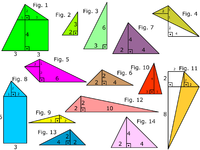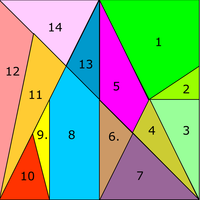Stomachion
Stomachion ( old Gr . Στομάχιον), actually Ostomachion (Ὀστομάχιον), is the title of a mathematical script by Archimedes , which has only survived fragmentarily in two manuscripts, an Arabic translation and one in the Greek original from a Byzantine manuscript from the 10th century (so-called Archimedes Palimpsest ).
The word "Stomachion", which is probably mutilated by the Arabic tradition, is correctly called "Ostomachion" by the Roman writer Ausonius (" quod Graeci ostomachion vocavere " "what the Greeks call Ostomachion"), as the Danish Archimedes researcher Johann L. Heiberg in his edition of Fragments could show. Etymologically there is either the meaning "bone competition" (from Greek ὀστέον osteon bone, leg and μάχη machê battle, fight) or "neck game" (from Latin stomachari to be angry, stomachus stomach, but also resentment, anger, Resentment, resentment, cf. Greek στόμαχος stomachos stomach).
In his work Archimedes describes a puzzle game in which figures can be placed from 14 ivory tiles initially arranged in a square, and analyzes the combinatory possibilities in how many ways the square can be laid.
It is not known whether Archimedes designed the game himself or only dealt with the geometrical problems of the existing puzzle.
The game
The Stomachion, also known as "Loculus Archimedius" or in English under the name "elephant puzzle," is the Chinese Tangram like laying and waiting game . The basic figure consists of a total of 14 triangles, squares and pentagons, which can be put together in various ways to form a square.
The aim of the game is to place figures that are as interesting as possible and that are reminiscent of familiar shapes, such as animals, people or objects. For example, the late ancient Roman statesman and poet Ausonius and other ancient writers name the following figures that can be made from the 14 parts: a helmet, a flying goose, a tower, a pillar, an elephant, a boar, a barking dog, a lurking hunter, a gladiator. That probably happened in a kind of competition with two or more players.
The math problem
The number of different ways to arrange the parts of the Stomachion within a square was determined in 2003 at the suggestion of the American science historians Reviel Netz and William Noel by four mathematicians in six weeks with the help of a computer program to a total of 17,152; this maximum number can be reduced to 536 if you do not count reflections and rotations.
literature
- Johan Ludvig Heiberg: Archimedis opera omnia , vol. 2. Teubner, Leipzig 1881, p. 420 ff.
- Charles Mugler: Archimède. Texts établi et traduit , vol. 3. Les Belles Lettres, Paris 1971.
- Jutta Väterlein: Roma invited . Children and adults playing games in ancient Rome. (= Heuremata. Studies on literature, languages and culture of antiquity. Vol. 5.) Grüner, Amsterdam 1976.
- Reviel Netz, William Noel: The Code of Archimedes. The most famous palimpsest in the world is deciphered. Beck, Munich 2007, ISBN 978-3-406-56336-2 .
- The secret of the Archimedes puzzle. In: DER SPIEGEL (52/2003) of December 20, 2003.
- Gina Kolata: In Archimedes' Puzzle, a New Eureka Moment. In: The New York Times, December 14, 2003.
Web links
- The ancient texts on the Stomachion , as well as an online playable version of the game on the website of the Bibliotheca Augustana (with instructions in Latin).
- Stomachion , a Graeco-Romanesque puzzle.
- Game information
- 268 solutions to the Stomachion ( PDF ; 131 kB)
- Display in mirror online



